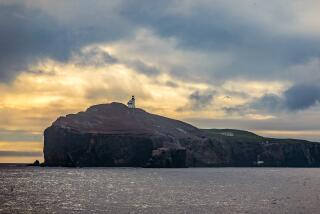Native Species Struggling for Survival on Galapagos Isles
- Share via
QUITO, Ecuador — On the Galapagos Islands, where Charles Darwin established his evolutionary theory of survival of the fittest, animals and plants brought by humans are killing endangered native species, a scientist says.
Foreign species ranging from fire ants to blackberry bushes are irreversibly harming plants and animals, said biologist Juan Black, secretary general of the Charles Darwin Foundation.
He said that biological disruption caused by the arrival of the new species is proving a more serious threat than a wildfire that destroyed about 700 square miles on the Galapagos in 1985 and drew international attention.
The Galapagos, an archipelago of volcanic islands about 600 miles off the coast of Ecuador, contain unique species of birds, giant land and marine tortoises, insects and plants.
Five-Week Visit
Darwin, a British scientist, visited the islands for five weeks in 1835 and collected evidence that led to his theory that species are subject to evolutionary change by natural selection.
Plants and animals introduced to the Galapagos have few or no natural predators or plagues. Black said they often spread easily, displacing native species or killing them.
Pigs, goats, donkeys and dogs brought to the islands by pirates and whalers in the 17th and 18th centuries have flourished and inflicted serious ecological harm, he said.
On the island of Santiago, experts estimate that there are 100,000 wild goats, 10,000 feral pigs and 2,000 donkeys. Scientists have fenced off unique plant communities to protect them.
Becoming a Desert
“The goats are turning Santiago into a desert, little by little,” Black said, adding that wardens have launched successful hunting campaigns but lack resources to completely kill off the intruders.
More recent introductions by tourists and some of the 8,000 permanent settlers in the Galapagos include pigeons, earthworms, fire ants and other species that fiercely compete against native animals.
Black said that earthworms have changed the structure and composition of soils on the island of Santa Cruz, killing native ferns. Fire ants feed on endangered spiders, a species of scorpion and even on newborn land turtles with yolks still attached.
On San Cristobal, one of the 13 major islands, settlers recently introduced blackberry bushes to make marmalade and beverages.
‘It Truly Is a Plague’
No one believed that the plant would be harmful, “but now it truly is a plague and no one knows what to do,” Black said.
An introduced crow-like bird, the ani, burgeoned in population in 1982 and 1983 on the island of Santa Cruz and is eating eggs from nests of finches, cuckoos and mockingbirds, he said.
More to Read
Sign up for Essential California
The most important California stories and recommendations in your inbox every morning.
You may occasionally receive promotional content from the Los Angeles Times.













